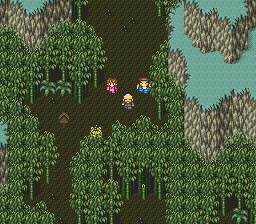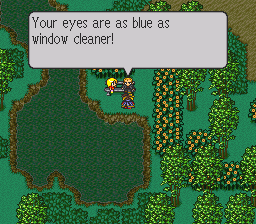





Live-A-Live an RPG developed and published by Squaresoft. It was released in September of 1994 for the Super Famicom. Live-A-Live was never officially released outside of Japan. However, in December of 2001, an unofficial English fan translation was released by Aeon Genesis Translations.
The game follows seven distinct scenarios scattered across different time periods, with two more unlockable scenarios linking the narratives together through the recurring antagonist Odio. The gameplay is split between exploration with story-specific twists, and turn-based combat played out on a grid.
Production began in late 1993 and was the directorial debut of Takashi Tokita. Tokita wanted to tell multiple stories within a single game, with each section drawing inspiration from different sources. Character designs for the seven main scenarios were handled by different manga artists. The music was composed by Yoko Shimomura as her first large-scale project after joining Squaresoft.
Takashi Tokita once mentioned that Square Enix was originally considering localization of Live-A-Live. But since “sales prospects in Japan did not seem particularly promising”, it was never released in other regions.
On July 22, 2022, the HD-2D Remake of Live-A-Live was released for Nintendo Switch. Later on April 27, 2023, it was released for PlayStation 4, PlayStation 5, and PC (Steam). “HD-2D” is a graphical style popularized by Octopath Traveler that renders 2D sprites in a side-scrolling 3D world. This was a true remake that's nearly identical to the original. Only some areas were rearranged in the interest of blending the game better for HD-2D (i.e. the Ninja Chapter's castle). Some quality of life features were added such as a maps + indicators for where to go next. If you want to see how this remake looks like, check out these screenshots and videos.
 An enemy encounter
An enemy encounter
Live-A-Live has a unique battle system you won't find in any other game. Enemies are present on the battlefield like in Chrono Trigger. Touching an enemy enters a battle. Battles are somewhat strategy RPG, similar to the battle system in Final Fantasy Tactics. Characters move around in a grid-like battlefield.
When it's your turn to attack on the grid-like battlefield, you can move around the grid as much as you want. But there's a catch - every few steps you take grants the enemy a turn as well! For example, let's say you're on the bottom left of the grid and you want to move to the upper right end of the grid in one turn. Traveling that distance may grant the enemy two or three turns! So how much you move in a turn is important to be done with caution.
 The grid-based battlefield
The grid-based battlefield
Your placement on the grid is another strategic aspect to keep in mind. Every attack (yours and that of the enemy) targets different surrounding tiles on the grid. For example, some attacks only attack top/right/bottom/left while others only attack diagonally. Sometimes enemies can push you against the edge of the grid and corner you. Certain attacks in the game can cover tiles on the grid with lava or poison which cause damage if you stay on them.
The game doesn't offer stores for purchasing weapons and armor. Rather, you're meant to be picking them up from defeated enemies or by finding them in hidden places (pots, chests, etc.). Weapons and armor are rather scarce (it's not a focus in the game) so it's important to always explore and find what you can!
One feature I love about the battle system is that all attacks can be used infinitely. If there's one attack you love in particular, you can use it over and over to your heart's content and not worry about MP consumption. HP is fully restored after every battle (like in SaGa games). When a character's HP reaches zero, you can revive them with any healing ability or item (no 'revive' item necessary). The catch is that you have one turn to revive a fallen character. If a fallen character is attacked, they disappear from the battlefield. They're not gone forever; they return with full HP after you win the battle.
 The game's humor
The game's humor
I love Live-A-Live so much. It's one of the handful of SNES RPGs that I keep coming back to. The unique battle system is fun and addicting. I love the manga art style of the character sprites in battle. The soundtrack is fantastic as well. This is a Japan-only gem that I am grateful is available in English thanks to the fan translation.
I love the variety offered by every chapter. The mini-stories are fun, captivating, and exciting. They keep the pace interesting by adding variety to how each scenario is played; each chapter is not a straight-forward linear RPG adventure. For example, the goal of the entire Wild West chapter is to collect items to build traps. The Future chapter doesn't even involve battles and is entirely story-driven.
 The on-going joke with the father
The on-going joke with the fatherSpeaking of the stories, I love how Live-A-Live can get pretty dark! There are some dark themes and sometimes people die in horrid ways. It's probably one of the reasons why the game was never released outside of Japan.
There are so many hilarious lines! See a sample toward the right. There's also this on-going joke throughout the chapters with some kid's father who gets killed, and he's like, “NOOOO!!”
One thing I don't like about Live-A-Live is how short it is. Tenchi Muyo RPG wins the crown as the shortest RPG I know of (takes around 7 hours). Live-A-Live takes around 20 hours to beat. It's even shorter if you make use of an emulator's fast forward feature to level grind.
Also, sometimes it can be tedious figuring out what to do next. You'll most likely find yourself looking up a walkthrough for help. And the final battles get pretty hard! You'll need to do a great deal of level-grinding.
Overall, I think Live-A-Live is excellent. I'd recommend it to any retro RPG fan.